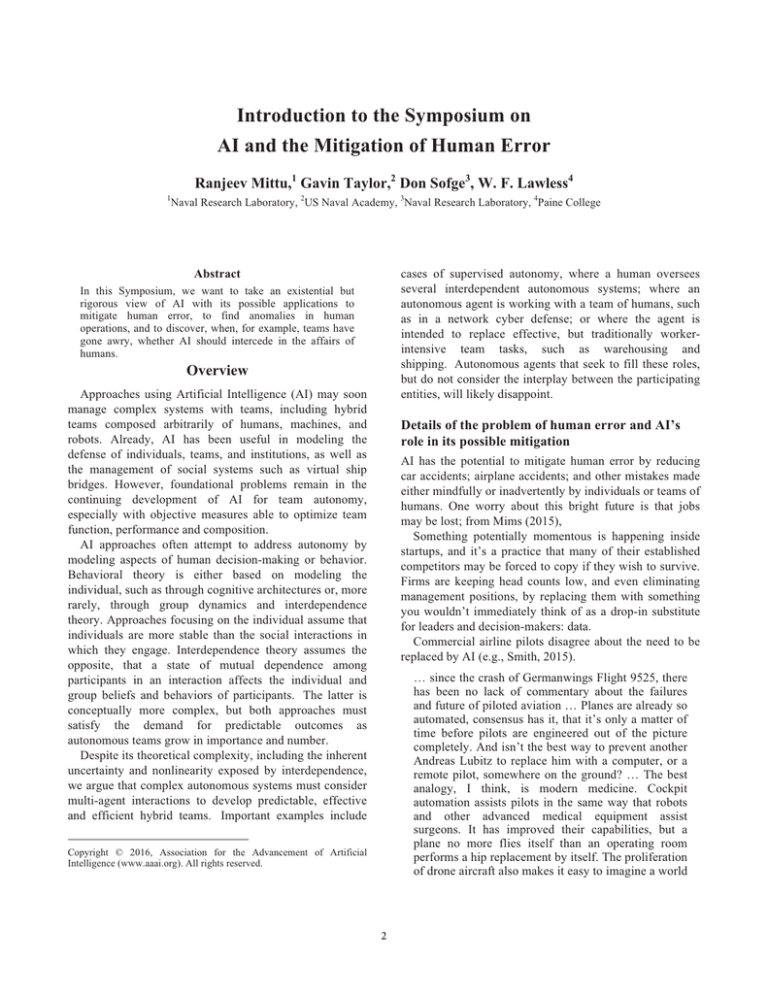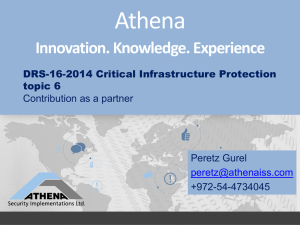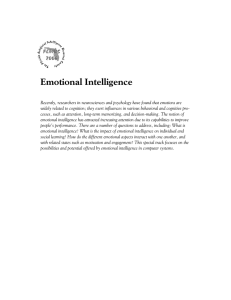
Introduction to the Symposium on
AI and the Mitigation of Human Error
Ranjeev Mittu,1 Gavin Taylor,2 Don Sofge3, W. F. Lawless4
1
Naval Research Laboratory, 2US Naval Academy, 3Naval Research Laboratory, 4Paine College
cases of supervised autonomy, where a human oversees
several interdependent autonomous systems; where an
autonomous agent is working with a team of humans, such
as in a network cyber defense; or where the agent is
intended to replace effective, but traditionally workerintensive team tasks, such as warehousing and
shipping. Autonomous agents that seek to fill these roles,
but do not consider the interplay between the participating
entities, will likely disappoint.
Abstract
In this Symposium, we want to take an existential but
rigorous view of AI with its possible applications to
mitigate human error, to find anomalies in human
operations, and to discover, when, for example, teams have
gone awry, whether AI should intercede in the affairs of
humans.
Overview
Approaches using Artificial Intelligence (AI) may soon
manage complex systems with teams, including hybrid
teams composed arbitrarily of humans, machines, and
robots. Already, AI has been useful in modeling the
defense of individuals, teams, and institutions, as well as
the management of social systems such as virtual ship
bridges. However, foundational problems remain in the
continuing development of AI for team autonomy,
especially with objective measures able to optimize team
function, performance and composition.
AI approaches often attempt to address autonomy by
modeling aspects of human decision-making or behavior.
Behavioral theory is either based on modeling the
individual, such as through cognitive architectures or, more
rarely, through group dynamics and interdependence
theory. Approaches focusing on the individual assume that
individuals are more stable than the social interactions in
which they engage. Interdependence theory assumes the
opposite, that a state of mutual dependence among
participants in an interaction affects the individual and
group beliefs and behaviors of participants. The latter is
conceptually more complex, but both approaches must
satisfy the demand for predictable outcomes as
autonomous teams grow in importance and number.
Despite its theoretical complexity, including the inherent
uncertainty and nonlinearity exposed by interdependence,
we argue that complex autonomous systems must consider
multi-agent interactions to develop predictable, effective
and efficient hybrid teams. Important examples include
Details of the problem of human error and AI’s
role in its possible mitigation
AI has the potential to mitigate human error by reducing
car accidents; airplane accidents; and other mistakes made
either mindfully or inadvertently by individuals or teams of
humans. One worry about this bright future is that jobs
may be lost; from Mims (2015),
Something potentially momentous is happening inside
startups, and it’s a practice that many of their established
competitors may be forced to copy if they wish to survive.
Firms are keeping head counts low, and even eliminating
management positions, by replacing them with something
you wouldn’t immediately think of as a drop-in substitute
for leaders and decision-makers: data.
Commercial airline pilots disagree about the need to be
replaced by AI (e.g., Smith, 2015).
… since the crash of Germanwings Flight 9525, there
has been no lack of commentary about the failures
and future of piloted aviation … Planes are already so
automated, consensus has it, that it’s only a matter of
time before pilots are engineered out of the picture
completely. And isn’t the best way to prevent another
Andreas Lubitz to replace him with a computer, or a
remote pilot, somewhere on the ground? … The best
analogy, I think, is modern medicine. Cockpit
automation assists pilots in the same way that robots
and other advanced medical equipment assist
surgeons. It has improved their capabilities, but a
plane no more flies itself than an operating room
performs a hip replacement by itself. The proliferation
of drone aircraft also makes it easy to imagine a world
Copyright © 2016, Association for the Advancement of Artificial
Intelligence (www.aaai.org). All rights reserved.
2
of remotely controlled passenger planes. … [but]
remember that drones have wholly different missions
from those of commercial aircraft, with a lot less at
stake if one crashes.
“History teaches us that when cuts are made in any
industry, the first things to go are safety and
training—always, every industry,” says Michael
Bromwich, who oversaw the regulatory overhaul after
the [Deepwater Horizon] disaster before stepping
down as head of the Bureau of Safety and
Environmental Enforcement in 2011 in 2011.
The diminution by an organization in its valuation of
safety coupled with human error led to the explosion in
2010 that doomed the Deepwater Horizon in the Gulf of
Mexico (Gilbert, 2015).
The mistakes that led to the disaster began months
before the Deepwater Horizon rig exploded, investigators
found, but poor decisions by BP and its contractors sealed
the rig’s fate—and their own. On the evening of April 20,
2010, crew members misinterpreted a crucial test and
realized too late that a dangerous gas bubble was rising
through the well. The gas blasted out of the well and
ignited on the rig floor, setting it ablaze.
Human error also emerges as a problem in the
management of civilian air traffic control (ATM). ATM’s
top five safety risks nearly always involve ‘Human Error’
(ICAO, 2014).
Human error was the cause attributed to the recent
sinking of a research ship (Normile, 2015):
The sinking of Taiwan's Ocean Researcher V last fall
resulted from human error, the head of the country's
Maritime and Port Bureau told local press this week. The
10 October accident claimed the lives of two researchers
and rendered the dedicated marine research ship a total
loss. ... Wen-chung Chi, director-general of the Maritime
and Port Bureau, said that a review of the ship's voyage
data recorder and other evidence indicated that the crew
should have been alerted that the ship had drifted off
course.
An even greater, existential threat posed by AI is to the
existence of humanity, raised separately by the eminent
physicist Stephen Hawkings, the entrepreneur Elon Musk
and the computer billionaire Bill Gates. Garland (2015),
the director of the new film “Ex Machina”, counters their
recent warnings:
... reason might be precisely the area where artificial
intelligence excels. I can imagine a world where
machine intelligence runs hospitals and health
services, allocating resources more quickly and
competently than any human counterpart. ... the
investigation into strong artificial intelligence might
also lead to understanding human consciousness, the
most interesting aspect of what we are. This in turn
could lead to machines that have our capacity for
reason and sentience ... [and] a different future. ... one
day, A.I. will be what survives of us.
In this Symposium, we want to take an existential but
rigorous view of AI with its possible applications to
mitigate human error, to find anomalies in human
operations, and to discover, when, for example, teams have
gone awry, whether AI should intercede in the affairs of
humans.
In the applications presented at this Symposium, we
want to explore both the human’s role in the cause of
accidents and the possible role of AI in mitigating human
error; in reducing problems with teams, like suicide (e.g.,
the German co-pilot, Libutz, who killed 150 aboard his
Germanwings commercial aircraft; from Kulish &
Eddymarch, 2015); and in reducing the mistakes by
military commanders (e.g., the sinking of the Japanese
tour-boat by the USS Greeneville; from Nathman et al.,
2001).
The role of AI in reducing future human error
The causes of human error could be attributed to
endogenous or exogenous factors (we discuss the latter
under anomalies and cyber threats). A primary endogenous
factor in human causes of accidents is either a lack of
situational awareness, or a convergence into an incomplete
state of awareness determined by culture greatly amplified
by emotions decision making (e.g., the Iranian Airbus
Flight 655 erroneously downed by the USS Vincennes in
1988; e.g., Lawless et al., 2013). Many other factors have
been subsumed under human error including poor problem
diagnoses; poor planning, communication and execution;
and poor organizational functioning.
What role can AI play in reducing human error? First,
Johnson (1973) proposed that the most effective way to
reduce human error is to make safety integral to
management and operations. Johnson’s “MORT” accident
tree-analyses attempts to identify the operational control
Introduction. Human error
Across a wide range of occupations and industries, human
error is the primary cause of accidents. Take, for example,
general aviation:
The National Safety Board found that in 2011, 94% of
fatal accidents occurred in general aviation (Fowler,
1994);
In general aviation, the Federal Aviation Administration
(FAA, 2014) attributed the accidents that occur primarily
to stalls and controlled flight into terrain, that is, to
avoidable human error.
Exacerbating the sources of human error, safety is the
one area an organization often skimps as it tries to save
money. From Gilbert (2015),
3
issues that may have caused an accident, and the
organizational barriers that resist uncovering the
deficiencies that contributed to an accident. MORT has
been prized by the Department of Energy as the ultimate
tool for identifying possible hazards to the safe operation
of nuclear reactors.
Second, checks and balances on cognitive convergence
processes permit the alternative interpretations of
situational awareness that may prevent human error.
Madison (1906) wrote that it is to free speech and a free
press, despite all their abuses, that “the world is indebted
for all the triumphs which have been gained by reason and
humanity over error and oppression.” But in closed
organizations, like the military in the cockpit or on a ship's
command bridge, the lack of free speech poses a threat that
is associated with an increase in errors. Based on
Smallman's (2012) plan to reduce accidents in the U.S.
Navy's submarine fleet with technology that illustrates the
range of opinions existing among a ship's staff for a
proposed action, in real time, AI can offer alternative
perspectives that oppose the very convergence processes
that permit errors to thrive (e.g., “groupthink”; Janis,
1982).
mutual information shared at the input and output of two
variables, forming a channel. Instead, for individual agents
forming a team, we devised a measure of team efficiency
based on the information transmitted by a team. We
concluded that (Moskowitz et al., 2015, p. 2), in general, a
“high degree of team player interdependence is desirable
(mapping to good performance). However this is not
always the case, certain tasks may require players to be
independent.” We also concluded that the “larger the
spectral radius of the topology of a team, the more efficient
it will be [and the easier for knowledge to spread], for all
other things being equal.” (pp. 7-8)
Bistable agents produce greater complexity. To form
teammates, we reconsidered agents as bistable to capture
the independent observation and action behaviors of
humans, or the multiple interpretations of reality common
to humans (Lawless et al., 2015). Bistability transforms
interdependence into a phenomenon similar to quantum
entanglement.
Building on our concept of efficiency, but with bistable
agents to replicate humans as observers and actors, we
noted that Shannon's team entropy is at a minimum for a
team slaved together. Contradicting Shannon except when
observation and action are perfectly aligned, or when
multiple interpretations converge in perfect agreement, in
our model, like the independent brain systems that observe
and act interdependently as a team, we set the baseline
entropy for a perfect team at least entropy production
(LEP).
With the bistable agent model, by increasing the energy
expended in teamwork, we concluded that the robust
intelligence necessary to succeed appears unlikely to occur
for agents acting independently, reducing autonomy and
thermodynamic effectiveness (e.g., productivity). By
multitasking (MT) together, a team of agents is more
effective than the same agents independently performing
the same tasks. For a team of bistable agents, however,
bias reduces its robust intelligence and autonomy. Instead,
robustness requires a MT team observing Reality to
contradict an opposing team (two teams of MTs best
capture situational awareness), implicating the value of
competition in determining Reality, but these two teams
are also insufficient for robustness. Robust intelligence
requires three teams: two opposing MT teams to construct
Reality plus a neutral team of freely moving bistable
independent agents attracted or repelled to one or another
team to optimize the thermodynamic forces that determine
team effectiveness and efficiency. Thus, given two
competitive teams, adding a third team to constitute a
spectrum of neutral bistable agents able to invest freely
(properties, ideas, works), act freely (joining and rejecting
either team), and observe freely makes the greatest
contribution to robust intelligence, to mitigating mistakes,
and to maximizing effective and efficient autonomy.
The role of AI in the discovery and rectification of
anomalies
An anomaly is a deviation from normal operations (Marble
et al., 2015). The factors we wish to consider are those
associated with cyberattacks; e.g., the subtle takeover of a
drone by a foreign agent. But, we expect, AI will be able to
be used proactively for “novel and intuitive techniques that
isolate and predict anomalous situations or state
trajectories within complex autonomous systems in terms
of mission context to allow efficient management of
aberrant behavior” (Taylor et al., 2015).
The role of AI in determining team metrics and shaping
team thermodynamics
In an earlier study of teams (Lawless et al., 2013), we had
concluded with a bold, well-supported assertion … that we
now conclude was wrong (e.g., Lawless et al., 2015). We
had come to believe that for AI, the psychology of the
individual is more or less a blind alley followed by many
social scientists ever since James (1890). While we are not
the only scientists to question the value of psychology
(e.g., Witkowski & Zatonski, 2015), we recant, somewhat.
Briefly, while teams enhance the performance of the
individual (Cooke & Hilton, 2015), the added time to
coordinate and communicate among a team’s members is a
cost and also a source of error. We propose that wellperforming teams can decrease the likelihood of human
error, poorly performing teams can increase human error.
We consider static and bistable agents.
With Shannon’s static, stable agents, the information
theory community appears to be more focused on the
4
Marble, J., Lawless, W.F., Mittu, R. Coyne, J., Abramson, M. &
Sibley, C. (2015), “The Human Factor in Cybersecurity: Robust
& Intelligent Defense”, in Cyber Warfare, Sushil Jajodia, Paulo
Shakarian, V.S. Subrahmanian, Vipin Swarup, Cliff Wang (Eds.),
Berlin: Springer.
Mims, C. (2015, 4/19), “Data Is the New Middle Manager.
Startups are keeping head counts low, and even eliminating
management positions, by replacing them with a surprising
substitute for leaders and decision-makers: data”, Wall Street
Journal,
from
http://www.wsj.com/articles/data-is-the-newmiddle-manager-1429478017
Moskowitz, Ira S., Lawless, W.F., Hyden, Paul, Mittu, Ranjeev &
Russell, Stephen (2015), A Network Science Approach to
Entropy and Training, Proceedings, AAAI Spring 2015, Stanford
University.
Nathman, J.B., VAdm USN; Sullivan, P.F., RAdm USN; Stone,
D.M., RAdm USN; & Ozawa, I., RAdm JMSDF (2001, April 13),
“Court of inquiry into the circumstances surrounding the collision
between USS Greenville (SSN 772) and Japanese M/V Ehime
Maru that occurred off the coast of Oahu, Hawaii on 9 February
2001; to Commander in Chief, U.S. Pacific Fleet, JAGMAN,
JAG-INST
5830.1;
from
news.findlaw.com/hdocs/docs/greeneville/ussgrnvl041301rprt.pdf
Normile, D. (2015, 3/27), "Human error led to sinking of
Taiwanese
research
vessel",
Science,
from
http://news.sciencemag.org/asiapacific/2015/03/human-error-ledsinking-taiwanese-research-vessel
Smallman, H. S. (2012). TAG (Team Assessment Grid): A
Coordinating Representation for submarine contact management.
SBIR Phase II Contract #: N00014-12-C-0389, ONR Command
Decision Making 6.1-6.2 Program Review.
Smith, P. (2015, 4/10), "Why Pilots Still Matter”, New York
Times, from http://www.nytimes.com/2015/04/10/opinion/whypilots-still-matter.html?ref=international&_r=1
Taylor, G., Mittu, R., Sibley, C., Coyne, J. & Lawless, W.F.
(2015, forthcoming), “Towards Modeling the Behavior of
Autonomous. Systems and Humans for Trusted Operations”, in
R. Mittu, D. Sofge, A. Wagner & W.F. Lawless (Eds), Robust
intelligence and trust in autonomous systems, Berlin: Springer.
Witkowski, T. & Zatonski, M. (2015), Psychology Gone Wrong:
The Dark Side of Science and Therapy. Brown Walker Press.
References
Cooke, N.J. & Hilton, M.L. (eds.) (2015, 4/24), Enhancing the
Effectiveness of Team Science, Committee on the Science of
Team Science, Board on Behavioral, Cognitive, and Sensory
Sciences, Division of Behavioral and Social Sciences and
Education, National Research Council, Washington, DC.
FAA (2014, July 30), “Fact Sheet – General Aviation Safety”,
U.S.
Federal
Aviation
Administration,
from
http://www.faa.gov/news/fact_sheets/news_story.cfm?newsId=16
774
Fowler, D. (2014, 7/16), “The Dangers of Private Planes”, New
York
Times,
from
http://www.nytimes.com/2014/07/17/opinion/The-Dangers-ofPrivate-Planes.html
Garland, A. (2015, 4/26), "Robot overlords? Maybe not; Alex
Garland of ‘Ex Machina’ Talks About Artificial Intelligence";
New
York
Times,
from
http://www.nytimes.com/2015/04/26/movies/alex-garland-of-exmachina-talks-about-artificial-intelligence.html?_r=0
Gilbert, D. (2015, 4/19), "Oil Rigs’ Biggest Risk: Human Error.
Five years after Deepwater Horizon, new rules and training go
only
so
far",
Wall
Street
Journal,
from
http://www.wsj.com/articles/rig-safety-five-years-after-gulf-spill1429475868
ICAO (2014, 8/8), “Integration of Human Factors in research,
operations and acquisition”, presented at the International Civil
Aviation Organization’s Second Meeting of the APANPIRG
ATM Sub-Group (ATM /SG/2)”, ATM/SG/2− IP04 0408/08/2014, Hong Kong, China, 04-08 August 2014
Kulish, N. & Eddymarch, M.A. (2015, 3/30), “Germanwings CoPilot Was Treated for ‘Suicidal Tendencies,’ Authorities Say”,
New
York
Times,
from
www.nytimes.com/2015/03/31/world/europe/germanwingscopilot-andreas-lubitz.html?_r=0
James, W. (1890), The principles of psychology, New York: Holt.
Janis, Irving L. (1982). Groupthink: Psychological Studies of
Policy Decisions and Fiascoes (2nd ed.). New York: Houghton
Mifflin.
Johnson, W.G. (1973), MORT: The management oversight and
risk tree, SAN 821-2. See the update by Knox, N.W. & Eicher,
R.W.(1992, Feb.), “MORT User’s Manual: For use with
Management Oversight and Risk Tree Analytical Logic
Diagram”, DOE/SSDC 76-45/4, Rev. 3. See also the International
Crises Management Association’s website: http://www.icmaweb.org.uk/06-9_mort.html
Lawless, W. F., Llinas, James, Mittu, Ranjeev, Sofge, Don,
Sibley, Ciara, Coyne, Joseph, & Russell, Stephen (2013). "Robust
Intelligence (RI) under uncertainty: Mathematical and conceptual
foundations of autonomous hybrid (human-machine-robot) teams,
organizations and systems." Structure & Dynamics 6(2),
from www.escholarship.org/uc/item/83b1t1zk.
Lawless, W.F.; Moskowitz, Ira S.; Mittu, Ranjeev; & Sofge,
Donald A. (2015), A Thermodynamics of Teams: Towards a
Robust Computational Model of Autonomous Teams,
Proceedings, AAAI Spring 2015, Stanford University.
Madison, J. (1906), "Report on the Virginia Resolutions, 17991800", in The writings of James Madison, G. Hunt (Ed.), New
York: Putnam & Sons, 6: 386.
5



